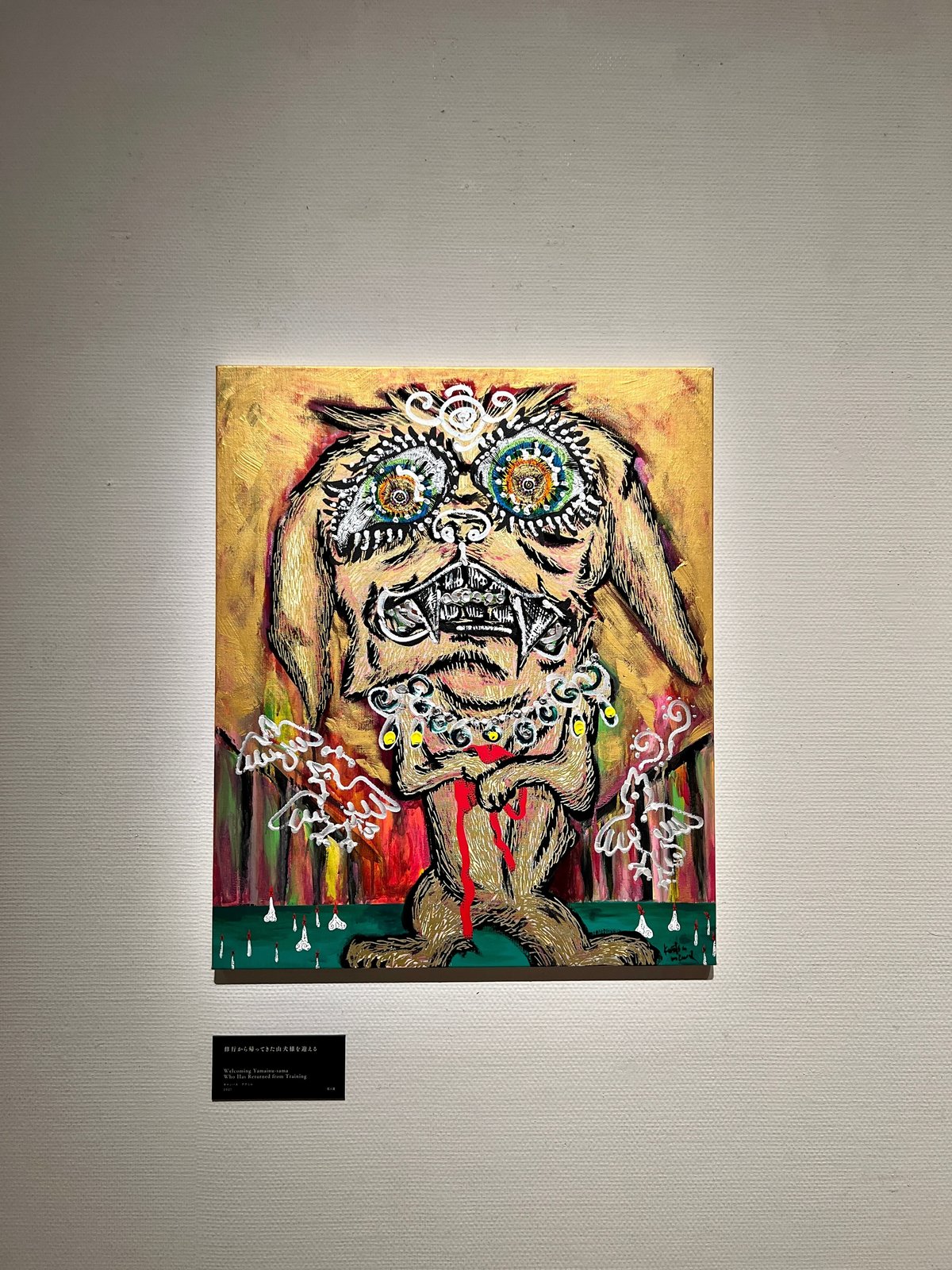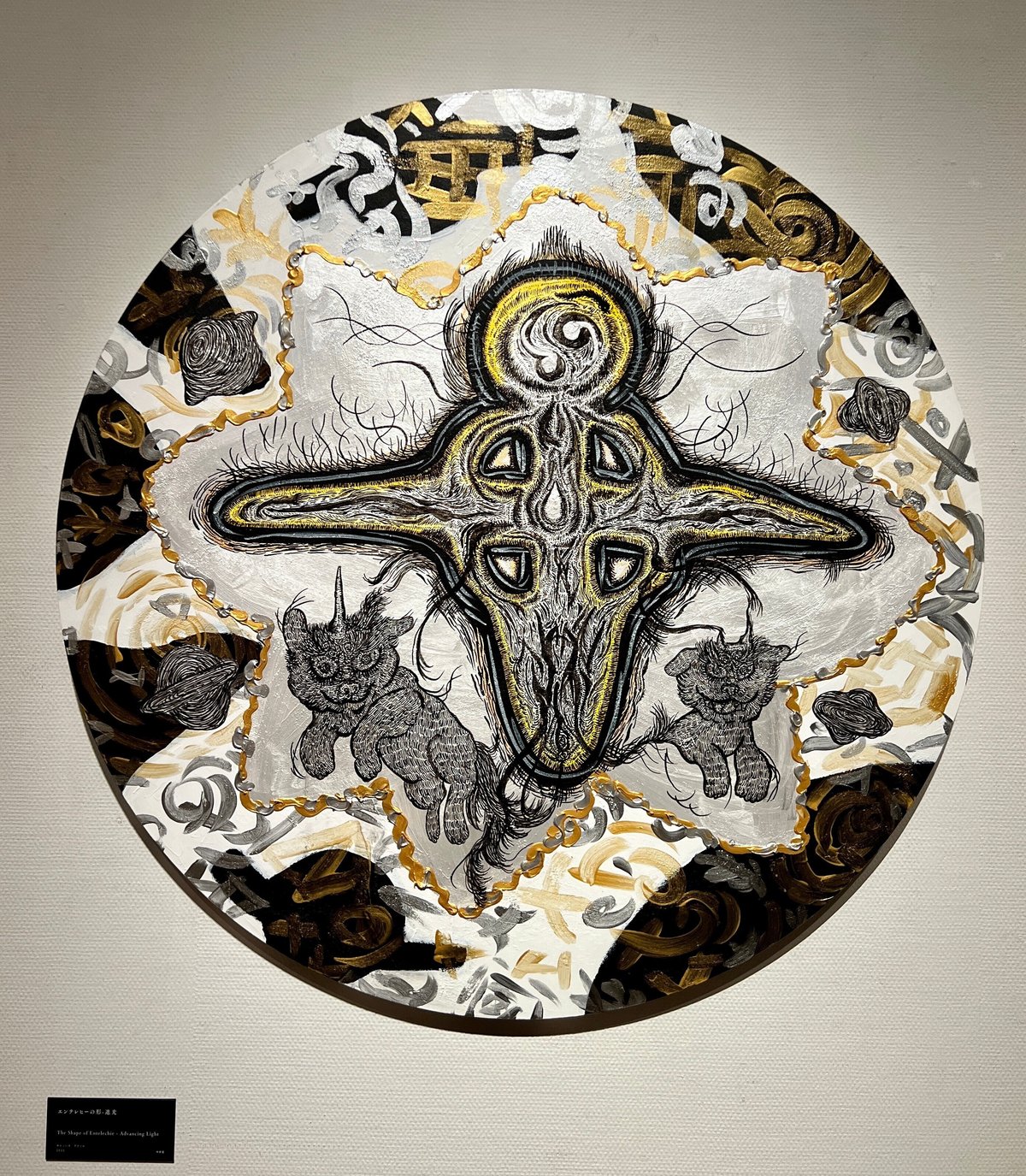
小松美羽の「神性」に楽しく感じ入る Enjoying Miwa Komatsu's "Divinity"
会期終了間際に川崎市岡本太郎美術館の「小松美羽展」(2022年8月28日まで)に駆け込んだ。小松美羽は1984年生まれ。女子美術大学に在籍した学生時代から現在までの作品を眺め渡すと、作風の変化がある中で「神性」というべきものが貫かれていることに、作家の強さを感じた。
すぐれた芸術作品には、多かれ少なかれ、神が宿っているものである。自分の手で作っているはずなのに、勝手に手が動いていたり、彫る前に彫った後の姿が見えていたり。美術だけでなく、音楽でも、その場でしかできない表現が忽然と表れたり、二度と再現できそうにない即興演奏ができたりするのは、そこに「神」がいるからだ。
小松の場合は、芸術家に内在する「神」に加えて、実際の宗教の世界ともかかわることで、さらに「神性」が高まっている。あるいは、芸術の「神性」と宗教の「神性」が絡み合っているというべきか。
ただし小松には、ただ宗教絵画を描いてきたのとは、かなり異なる経緯がある。まずは、2011年にニューヨークに渡って、自分が井の中の蛙でしかないことに気づき、それまでの代表作だった《四十九日》の銅版切断を決意したことだ。
Near the end of the exhibition, I rushed to the "Komatsu Miwa Exhibition" at Taro Okamoto Museum of Art ,Kawasaki (until August 28, 2022). Miwa Komatsu was born in 1984. Looking over her works from her student days at Joshibi University of Art and Design to the present, I felt the strength of the artist in the fact that "divinity" has been penetrated in the midst of changes in style.
A great work of art is, to a greater or lesser extent, inhabited by God. Even though you are supposed to be making it with your own hands, your hands are moving without permission, and you can see the appearance after carving before carving. Not only in art, but also in music, expressions that can only be performed on the spot suddenly appear, and improvisations that are unlikely to be reproduced again are because "God" is there.
In Komatsu's case, in addition to the "God" inherent in the artist, her involvement with the actual world of religion further heightens her "divinity." Or should we say that the "divinity" of art and the "divinity" of religion are intertwined?
Komatsu, however, has a very different history from just painting religious paintings. First of all, when she went to New York in 2011, she realized that she was nothing but a frog in the well, and she decided to cut the copper plate of "Forty-nine Days," which had been a masterpiece until then.

Exhibition view of "Forty-Nine Days" (2004, copper engraving)
大学在学中の作品と推定される《四十九日》は仏教とのつながりを感じさせるが、テーマのみならず、当時から小松の心の中に内在していたと思われる芸術家としての「神性」に満ちた素晴らしい作品だ。銅版切断という行為の是非にはいろいろな意見がありそうだが、少なくとも過去の作風や技法に決別を図るという点では、作家としての飛躍に本当に必要な行為だったのだろう。作家がいったん確立した技法を捨てるには、よほどの覚悟が必要だ。「無の境地を求めた」と言ってもいいかもしれない。
その後、色を表現の重要な要件にする方向に変わる。犬(らしき妖獣)をモチーフにした絵画やFRPによる彫刻には、なかなかかわいいものが多い。だが、ただかわいいわけではなくて、やはり神が小松の手を動かしているように見える。かわいいのだが、強い。特に山犬は小松にとって霊的な存在らしい。山犬を題材にしたたくさんの作品が展示されていた。
これらは、見ていて楽しい作品群でもある。神性があるのだが、決して高い場所から見下ろしているわけではない。むしろ、山犬が人間と意識を通じ合った身近な存在であることを感じさせる。
"Forty-Nine Days," which is presumed to be a work while still in college, evokes a connection with Buddhism, but it is a wonderful work full of not only themes but also the "divinity" as an artist that seems to have been inherent in Komatsu's mind from that time. There may be various opinions on the pros and cons of the act of cutting copper plates, but at least in terms of breaking away from past styles and techniques, it was probably an act that was really necessary for a leap forward as a creator. It takes a lot of determination for a creator to abandon a technique once established. It might be better to say that she "sought a state of nothingness."
It then changes to making color an important requirement for representation. Many of the paintings with dog (a kind of fairy beast) motif and sculptures by FRP are quite cute. But it's not just cute, it's still like God is moving Komatsu's hand. Cute, but strong. Mountain dogs, in particular, seem to be spiritual to Komatsu. There were many works on display about mountain dogs.
These are also a group of works that are fun to watch. It has divinity, but it is by no means looking down from a high place. Rather, it makes us feel that mountain dogs are familiar beings through human consciousness.





"Welcoming the Mountain Dog Returning from Training" (2021, Canvas, Acrylic) Exhibition view
この展覧会では、京都の東寺(教王護国寺)に来年奉納する《ネクストマンダラー大調和》(二幅一対)が特別に公開されていた。真言宗最高法儀と言われる後七日御修法の際に用いられる両界曼荼羅図(元禄本)とほぼ同サイズという、4m☓4mの大作2点だ。小松は、東寺の食堂にこもって制作したという。伝統ある寺院が、現代の画家にこうした作品の制作を任せること自体も、文化を未来につないでいく上で、素晴らしいことだと感じる。
In this exhibition, the "Next Mandala -Grand Harmony" (two widths and one pair), which will be dedicated next year at the Toji Temple (Kyo-ohgokuji) in Kyoto, was specially exhibited. It is two large-scale works of 4 m to 4 m, almost the same size as the Ryokai mandala diagram (Genroku edition) used during the Seven Days Practice of the Shingon Sect, which is said to be the Supreme Law of the Shingon Sect. Komatsu is said to have made it while staying in the restaurant of Toji Temple. I feel that it is wonderful for a traditional temple to entrust the production of such works to a contemporary painter in order to connect culture to the future.

From "Next Mandala-Grand Harmony"
小型の作品にも、曼荼羅を思わせるものがいくつもあった。
Even in the small works, there were many things reminiscent of mandalas.

山犬が飛び出してきている。
"Entelehee's Shape Light Advancing"
A mountain dog is jumping out.

真ん中に小さな仏像のようなモチーフが見える。
"The Shape of Entelehey Electric Field"
You can see a motif like a small Buddha image in the middle.
具象のようであり、抽象のようでもある。心の中からほとばしり出る何かを描き出すことにおいては、おそらく具象も抽象もないのだろう。だからこそ、小松の作品は、エネルギーに満ちあふれているのだ。
It is like a concrete image, and it is also like an abstraction. In depicting something that gushes out of the mind, there is probably no concreteness or abstraction. That's why Komatsu's work is full of energy.
written by Atsuo Ogawa

展覧会名:小松美羽展 岡本太郎に挑む―霊性とマンダラ
会場:川崎市岡本太郎美術館
会期:2022年06月25日 (土)-2022年08月28日 (日)
Exhibition Name: Miwa Komatsu Exhibition Challenging Taro Okamoto - Spirituality and Mandala
Venue: Taro Okamoto Museum of Art, Kawasaki
Period: 2022/06/25 (Sat) - 2022/08/28 (Sun)
Official Website:https://www.taromuseum.jp/exhibition.html
